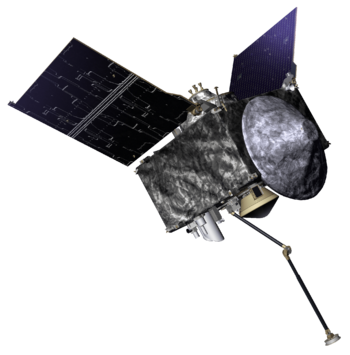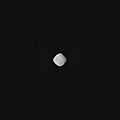OSIRIS-REx facts for kids

Artist's rendering of the OSIRIS-REx spacecraft
|
|
| Names | OSIRIS-REx New Frontiers 3 OSIRIS-APEX |
|---|---|
| Mission type | Asteroid sample return |
| Operator | NASA / Lockheed Martin |
| Mission duration | 7 years (planned) 889 days at asteroid (actual) 8 years, 7 months, 17 days (elapsed) |
| Spacecraft properties | |
| Manufacturer | Lockheed Martin |
| Launch mass | 2,110 kg (4,650 lb) |
| Dry mass | 880 kg (1,940 lb) |
| Dimensions | 2.44 × 2.44 × 3.15 m (8 ft 0 in × 8 ft 0 in × 10 ft 4 in) |
| Power | 1226 to 3000 watts |
| Start of mission | |
| Launch date | 8 September 2016, 23:05 UTC |
| Rocket | Atlas V 411 (AV-067) |
| Launch site | Cape Canaveral SLC-41 |
| Contractor | United Launch Alliance (ULA) |
| End of mission | |
| Disposal | Sample Return Capsule: Recovered |
| Landing date | Sample Return Capsule: 24 September 2023, 14:52 UTC |
| Landing site | Utah Test and Training Range |
| Orbital parameters | |
| Reference system | Bennu-centric |
| Altitude | 0.68–2.1 km (0.42–1.30 mi) |
| Period | 22–62 hours |
| Flyby of Earth | |
| Closest approach | 22 September 2017 |
| Distance | 17,237 km (10,711 mi) |
| Bennu orbiter | |
| Orbital insertion | 31 December 2018 (Rendezvous: 3 December 2018) |
| Orbital departure | 10 May 2021 |
| Sample mass | Between 60 g (2.1 oz) and 2,000 g (71 oz) |
| Bennu lander | |
| Landing date | 20 October 2020, 22:13 UTC |
| Landing site | "Nightingale" |
| Flyby of Bennu | |
| Closest approach | 7 April 2021 |
| Distance | 3.5 km (2.2 mi) |
 OSIRIS-REx mission logo New Frontiers program
|
|
OSIRIS-REx was a NASA asteroid-study and sample-return mission that visited and collected samples from 101955 Bennu, a carbonaceous near-Earth asteroid. The material, returned in September 2023, is expected to enable scientists to learn more about the formation and evolution of the Solar System, its initial stages of planet formation, and the source of organic compounds that led to the formation of life on Earth. Following the completion of the primary mission, the spacecraft is planned to conduct proximity operations and in-depth study of asteroid 99942 Apophis as OSIRIS-APEX. The spacecraft will arrive at Apophis in April 2029, around when the asteroid is expected to encounter Earth.
Bennu was chosen as the target of study because it is a "time capsule" from the birth of the Solar System. Bennu has a very dark surface and is classified as a B-type asteroid, a sub-type of the carbonaceous C-type asteroids. Such asteroids are considered primitive, having undergone little geological change from their time of formation. In particular, Bennu was selected because of the availability of pristine carbonaceous material, a key element in organic molecules necessary for life as well as representative of matter from before the formation of Earth. Organic molecules, such as amino acids, have previously been found in meteorite and comet samples, indicating that some ingredients necessary for life can be naturally synthesized in outer space.
Mission
The acronym OSIRIS was chosen in reference to the ancient mythological Egyptian god Osiris, the underworld lord of the dead.
Overall management, engineering and navigation for the mission was provided by NASA's Goddard Space Flight Center. The science team included members from the United States, Canada, France, Germany, United Kingdom, and Italy.
OSIRIS-REx was launched on 8 September 2016. After traveling for approximately two years, the spacecraft reached the asteroid in December 2018, and began 505 days of surface mapping at a distance of approximately 5 km (3.1 mi). Results of that mapping were used by the mission team to select the site from which to take a sample of the asteroid's surface. Then a close approach (without landing) was carried out to allow extension of a robotic arm to gather the sample.
Following the collection of material (>60 grams), the sample was returned to Earth in a 46 kg (101 lb) capsule similar to that which returned the samples of a comet 81P/Wild on the Stardust spacecraft. The return trip to Earth was shorter and the capsule landed by parachute at the Utah Test and Training Range on 24 September 2023 before being transported to the Johnson Space Center for processing in a dedicated research facility.
Images for kids
-
Asteroid Bennu, imaged by the OSIRIS-REx probe, 3 December 2018
-
Animation of OSIRIS-REx's trajectory from 9 September 2016 OSIRIS-REx · 101955 Bennu · Earth
-
Animation of OSIRIS-REx's trajectory around 101955 Bennu from 25 December 2018 OSIRIS-REx · 101955 Bennu
See also
 In Spanish: OSIRIS-REx para niños
In Spanish: OSIRIS-REx para niños





















